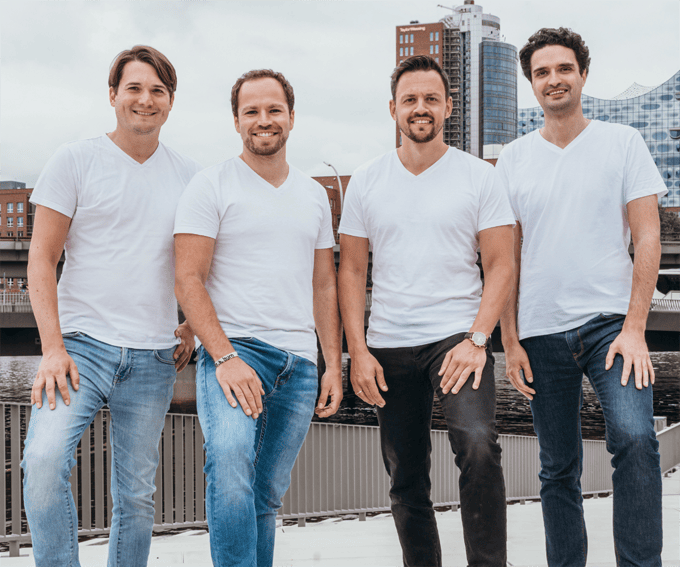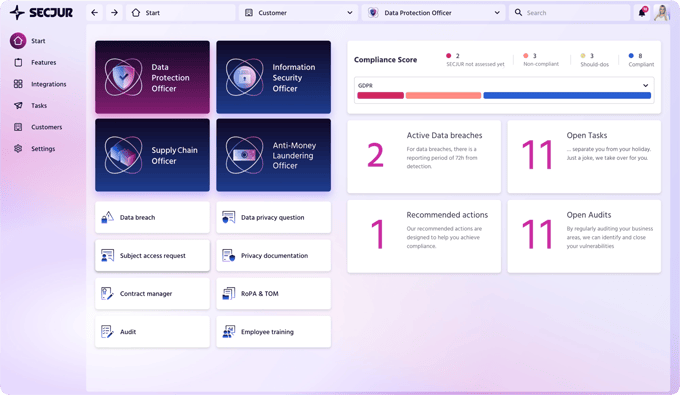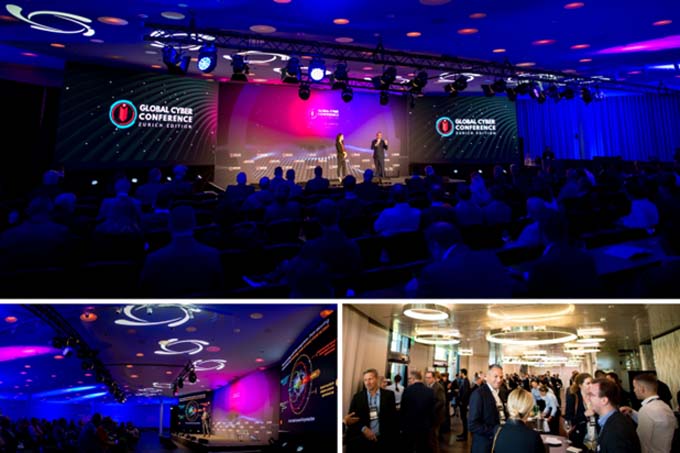Automated compliance: German start-up expands into Switzerland
New data protection laws, increasing regulation, greater risk of cyber attacks: The challenges for entrepreneurs are becoming ever greater. The German legal tech start-up Secjur is now expanding into Switzerland and offering AI-supported compliance solutions.

Stahl, Simon Pentzien and Sven Moritz. (Image: zVg / Secjur)
A new Data Protection Act (revDSG) will come into force in Germany on September 1. All companies will then be obliged to adapt to the revised regulations, which are aligned with the EU directives. Secjur's founders are very familiar with the EU regulations. In 2018, Niklas Hanitsch and Manuel Stahl founded their start-up for automated compliance, with Simon Pentzien and Sven Moritz joining as co-founders by 2021. Since then, they have won the German Start-up Cup for their solution and convinced venture capital companies and prominent angel investors of their solution for automated compliance. Just in time for the adaptation to the EU data protection law, they launch their business in Switzerland with offices in Bern and Zurich.
Revolutionize compliance with automation
Compliance has become a challenge for companies of all sizes, and the work behind it is often manual, repetitive and expensive. Hamburg-based Secjur has developed its Digital Compliance Office, an AI-based automation platform for compliance processes that can save hundreds of man-hours. Secjur helps companies in diverse industries digitally automate their compliance processes, including data protection, information security, anti-money laundering and whistleblowing. In addition to international corporations such as Siemens and Samsung, customers primarily include SMEs and fast-growing companies such as Tomorrow Bank. "In the coming years, there will be many more compliance challenges, such as the AI regulation. Regulation can help protect consumers' rights and make both the digital and the real world a better place," says lawyer and Chief Innovation Officer Niklas Hanitsch.
Leveraging knowledge in Switzerland
With the new data protection law in Switzerland, Secjur's founders recognize the optimal time to implement their expansion strategy in the DACH region. In addition to the more than 70 employees in Hamburg, Berlin, Regensburg and Munich, around 20 employees will in future look after the Swiss business from Berne and Zurich. "In Germany, we have already easily implemented the General Data Protection Regulation for many hundreds of companies in 2018. With this head start in knowledge and our intelligent platform, we support our Swiss customers in correctly implementing all requirements right from the start." Secjur addresses both corporate groups and SMEs that want to create trust among customers and partners, prevent cybercrime, avoid fines and optimize processes.

Expertise and audits at the touch of a button
Secjur's data protection experts are familiar with the specifics of over 60 industries and identify corresponding risks and compliance challenges. Secjur's data protection solution, Digital Compliance Office, provides a comprehensive overview of all relevant processes and documents and is easy to use even for beginners. The central control of all compliance issues saves time-consuming multiple audits: With over 60 API connections (such as Jira, Slack, Hubspot, Salesforce or Lexoffice), Secjur easily integrates into existing tech stacks. This allows audits to be partially automated - and specific recommendations for action to be generated at the push of a button. For a company with around 50 employees, the audit effort can be reduced from around 14 to 2 hours per week so far, and from around 23 to 2 hours for 250 employees - an immense resource saving. The data is hosted in Germany.
Ambition and prominent investors
"We aim to offer the best and most widely used compliance automation solution in the world," says co-founder Manuel Stahl. The founders' subject matter expertise in the key fields of law, IT, finance and business gives Secjur a distinct advantage. One of Secjur's key investors is the Berlin-based Visionaries Club, which manages a €600 million venture capital fund. The club is supported by a network of founders of companies such as Flixbus, Spotify and Hello Fresh as well as family-run business dynasties such as Swarovski, Miele, Siemens and Stihl. The circle of investors also includes business angels who support Secjur financially and in an advisory capacity. Among them are prominent personalities such as soccer star Mario Götze and Formula 1 World Champion Nico Rosberg.
For individuals interested in learning more about the new data protection law and Secjur's solutions, the company is offering a free webinar on Sept. 4, 2023, at 12 p.m. Learn more at www.secjur.com
This article originally appeared on m-q.ch - https://www.m-q.ch/de/automatisierte-compliance-deutsches-start-up-expandiert-in-die-schweiz/





























 Linda, the little potato, tells about her journey herself right away: It took a long time for the potato to get from South America to Europe. And things didn't always go smoothly either. While Linda was popular in South America and had been planted for thousands of years, Europeans didn't want to eat potatoes at all. Eventually, however, the potato became one of the most important plant foods in Europe.
Linda, the little potato, tells about her journey herself right away: It took a long time for the potato to get from South America to Europe. And things didn't always go smoothly either. While Linda was popular in South America and had been planted for thousands of years, Europeans didn't want to eat potatoes at all. Eventually, however, the potato became one of the most important plant foods in Europe.


